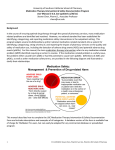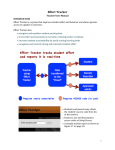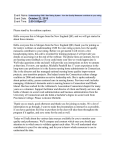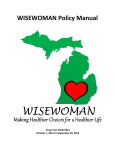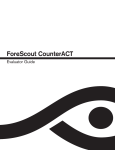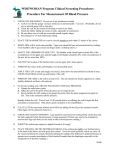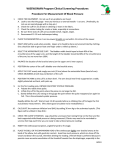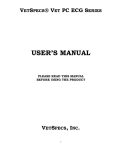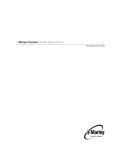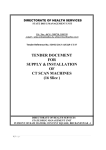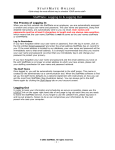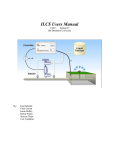Download Nursing Home Quality Data Webinar Transcript - Mountain
Transcript
Event ID: 2647107 Event Started: 6/30/2015 3:47:56 PM ET Please stand by for real time captions. Welcome to the nursing home quality David -- data conference call. At this time all participants are in a listen only mode and later we will conduct a question-and-answer session. Please note that this conference is also being recorded. I would like to turn the call over. Ms. Johnson you may begin. Hi welcome and thanks for joining the webinar today. My name is Elizabeth Johnson and I will be hosting today's program. This webinar is brought to you by mountain Pacific quality health quality improvement network organization serving Alaska Montana Wyoming and Hawaii and partnership with the queue I am QIO of the great eight plus group which includes Colorado, Illinois, Iowa, Kansas, Minnesota, Michigan, Nebraska, Nevada, New Mexico, North Dakota, Oregon, South Dakota, Utah and Wisconsin. A few housekeeping items. The handouts for today's presentation were distributed yesterday, Monday, on the 29th. If you have not received them please contact your state QIO and you may e-mail me and I will send them to you following the WebEx. I will put my e-mail address in the chat box as soon as I am done. To enhance the learning experience, we will be muting all lines. Please feel free to put any questions or comments in the chat box as we move along. I would like to introduce our speakers today. Marilyn Reierson and Kelly O'Neill our national leaders in the healthcare quality improvement. Together they provide leadership for resting quality improvement and safety activities in nursing homes across the country. Also key developers of tools and resources for QAPI but don't blame them for the acronym. Thank you Marilyn and Kelly, passing the baton to you. Great, thank you so much. We are pleased to be here today and we are going to be exploring the three data sources that can support your quality improvement efforts organizationally. As Weiser said my name is Marilyn Reierson and I'm pleased to introduce you to my colleagues Kelly O'Neill and Jeanne Carls. We are members of the national coordinating center and we support quality innovation network Quality Improvement Organizations as well is nursing homes across the nation and improving the quality of care and quality of life for nursing home residents. We are pleased to have this opportunity to be with you today. The objective of the presentation today is for you to be able to recognize, explain, and use several data sources to support quality improvement efforts in your organization. First, gene will present the 5-Star rating system and implication of the February 2015 updates. Then Kelly is going to present helpful information about using some of the CASPER reports. And you will hear from you little bit later in the webinar on the quality measure composite score. Please feel free to participate using the chat feature throughout the webinar. We will try to address your questions throughout the presentation and look forward to hearing a little bit more from you on how you are using these various data sources to support quality. Without further ado, let's hear from Jeanne Carls about the 5-Star ratings system. Hi, this is Jeanne. As you know, nursing home compare is a public reporting website that includes detailed information about every Medicare or Medicaid certified nursing home in the United States. It allows consumers, providers, state, and researchers to compare information on nursing homes. Him the website gets more than 1.4 million visitors per year. Public reporting and trends towards transparency with data are here to stay. Knowing your data and how to use it for improvement efforts within your organization is important. You may know that CMS added the 5-Star quality ratings system to the CMS nursing home compare website in December of 2008. It was added to assist the public in identifying meaningful distinctions among providers. The 5-Star quality ratings system list and overall rating for each facility they stun facility performance on three separate measures each of which has its own 5-Star rating. The 5-Star quality ratings system provides a summary of three dimensions of nursing home quality, health inspection results, staffing data, and quality measure data. Let's look at each of these in a little more detail. The health and inspections rating is based on outcomes from state health inspections. These ratings are based on the relative performance of facilities within a state. CMS chose to compare facilities to each other within a state to help control for variation among states the results from different management practices, differences in state licensing laws, and differences in state Medicaid policies. The rating system reflects the finding of approximately 180,000 on-site inspections of nursing homes over the most recent three year period. Quality measures are calculated using MDS assessments. Currently the quality measure rating incorporates 11 different measures for nursing home residents. Eight our long stay and three our short stay. The 11 core measures are calculated on the three most recent quarters of available data reported by the nursing home. The staffing rating reflects staffing levels based on the number of hours of care provided on average to each resident, each day by nursing staff and the number of residents in the facility. CMS aces facility staffing rating on two components. The number of registered nurse hours per resident they and the staffing hours of RNs plus LP and plus nurse eight hours per resident day. Staffing data are submitted by the facility and art case mix adjusted for different levels of resident care needs. Nursing home with residence with more severe needs would be expected to have more nursing staff than a nursing home where the residents needs were not aside. Based on the 5-Star ratings for the health inspection domain, the direct care staffing domain and the quality measure domain, the overall composite rating is been assigned. In February of 2015, CMS announced an expanded 5-Star quality ratings system for nursing homes. Let's review the key changes. In 2015, CMS added to quality measures for antipsychotic medication use to the 5-Star calculation. One measure for short stay and one measure for long stay residents. In calculating use of antipsychotics, CMS excludes use of antipsychotic medications for individuals who have been diagnosed with schizophrenia, Huntington's disease, or Tourette's syndrome. CMS has raised performance expectations by raising the standards for nursing homes to achieve a high rating on all publicly reported measures in the quality measures category. CMS will use fixed numeric thresholds and boundaries between me star categories. Providers can see the number they must obtain an order to move up by one star. This is explained further in the 5-Star quality ratings system technical users guide and this link is included in an upcoming slide. It is important to note that CMS expects there to be progress over time and one progress is achieved, the distribution may be reset again. Staffing algorithms were adjusted to more accurately reflect staffing levels and nursing homes muster four stars him on either the individual RN only or the staffing category to receive four stars on the overall staffing rating. Following the pilot, and fiscal year 2014, CMS is planning to expand the target survey. State survey agencies will conduct specialized unannounced on-site inspections of selected nursing homes across the United States. This process was designed to enhance verification of both the staffing and quality measure information. If you are interest did in more information, there is a report on the results of the pilot survey completed in 2014 and five states that is available on the CMS .gov website. The changes we have described can have an impact on a facilities overall rating. For example, as CMS raises the threshold for performance on the quality measures, some nursing homes have seen for me initially see a decline in their quality measures rating. Until further improvements are made. Because the quality measure scores are also used as part of the overall rating, some nursing homes will experience a decline in there overall 5-Star rating. However, a decline in a nursing home 5-Star rating absent any new survey information does not necessarily represent a sudden decline in quality. A change in a nursing home quality measure star rating may result from the addition of the antipsychotic data into the quality measure star rating or from the rebasing of the quality measure star boundary line. Also, CMS currently sets thresholds so that the overall proportion of nursing homes is approximately 25% 5Star, 20% for each of the two, three, and four stars and 15% one star for each rating category in February 2015. The cut points associated with the star ratings will be held constant for a period of at least one year, allowing the distribution of the quality measures rating to change over time. Let's look at the distribution. Him as we noted some nursing homes may have a lower overall rating after the recent changes to the ratings system. This is a bar chart that compares the percentage of nursing homes in each rating from April 2014 before the changes were made and in April 2015 after the changes were made. The data is publicly available through the nursing home compare site. Let's talk about how to interpret this chart. Looking at the bars labeled number one for overall rating of one star you can see that in April 2014, about 10% of nursing homes had an overall rating of one star. In April 2015, approximately 15% of nursing homes had an overall rating of one star. The percentage of homes with ratings of two and three stars overall are more similar all -- similar before and after the changes were made. Fewer nursing homes have a rating of four star and 5-Star than before the changes were made. If you look at the 5-Star rating, in April 2014, about 26% of nursing homes had an overall rating of five stars. In April of 2015, approximately 22% of nursing homes had an overall rating of five hours. Of note, CMS is implementing a system of quarterly electronic reporting that is auditable by referring to payroll that will verify staffing information. This new system is expected to increase accuracy and timeliness of data and allow for the calculation of quality measures for staff turnover, retention, types of staffing, and levels of different types of staffing. Additional details are available on the calculation of the ratings system in CMS five Star quality ratings system technical users guide. Available at the link on this slide. Next, I will turn this over to Kelly to talk about CASPER reports. Thanks Jeanne and hi everyone my name is Kelly O'Neill and I will provide a brief overview him of the types of CASPER reports of able and suggest ways to use those for quality assurance and performance improvement. I would encourage you to share your thoughts and suggestions on using these reports through the chat function today. I am sure that your colleagues on the call would appreciate hearing how you use the reports, what do you find particularly helpful about them? And if you have any questions, please enter those in the chat function as well, and we will get back to you on those. CASPER is CMS reporting application and stands for certification in survey provider enhanced report. Nursing homes access this application through the welcome to the CMS system for providers page and then by selecting the CASPER reporting link which is circled on the screenshot on this page. There are detailed instructions for accessing and using CASPER reports. You can access the users guide for CASPER on you're welcome page or at the link shown on the slide. A circle of the location for choosing the different sections which are listed on this slide. I won't go into a lot of detail today on the functionality of the sites, but know that the users guide is a great resource. Once you have select did the Casper report -- CASPER reporting link you're connected to the QI ES national system log in page. Quality improvement and evaluation system. Him when you enter your login information the CASPER topic homepage displayed as shown on the slide on the right. You can feelings to the various functions available, such as logout, folders reports etc.. The main function will focus on today is reports. These reports are really excellent resources for QAPI in your organization to help you understand areas where you are doing well and where you might need improvement. The report category came on the left with the various report categories that are available to you. Some reports are restricted to specific users or user groups. The report categories available to you may be different from those shown on this slide. Today I will talk about two other report categories. The MDS three-point oh, nursing home or provide a report, the MDS 3.0 quality measure or QM report. When I select MDS three-point oh, and H providers cannot be available report in that category appear in the right pane and the 14 reports listed in the right pane are pretty standard -- standard for all nursing homes. When you select a report from those listed in the right pane, generally you will see a criteria selection page. That allows you to enter criteria. Often you'll have the choice to select from a drop-down list of reporting timeframe options such as prior year, fiscal year today, prior quarter, month today, prior month, prior business week, prior business day or today for example. You select be timeframe that you are interested in for your chosen report. I'll briefly discuss each of these reports in the MDS 3.0 and each so you can get an idea of the type of information that is available to you. 0003 B and 4 D are produced as a package and improve provider history, profiles and survey information including deficiencies for the current year. The users guide contains examples of all these reports along with a description of each data elements or fields included in the report. Here is an example of page one of the provider history profile report. All the examples I will show you today are taken from CMS CASPER user guide. The MDS three-point oh activity report list the expected assessment that you submitted as well as in activation request. This report can be useful to evaluate if assessments were submitted and also to evaluate your workload and staffing. The admission/reentry report. Resident submitted during your chosen time period and can be compared to your facility roster report which will talk about an imminent to make sure each new resident has an entry accepted in the database. The MDS assessment with error numbers allows you to select error numbers you want to study. You can select up to five error numbers and then select a time period and you'll get a detailed list of assessments submitted with your specified error numbers. You might for example look for a fatal error such as inconsistent reasons for assessment. This report can help you determine which assessments need to be corrected and resubmitted, can help you look for problems that could be addressed with additional training or other types of support. And to identify any software related problems. Here's an example of the assessment with error number reports. Him -- the discharge report lists your resident discharge during your selected time period. You can compare this to your roster report to see if residents discharge assessments were accepted in the database. The error detailed by facility report shows errors encountered in successful submissions, and it can be used to identify errors that I are occurring and these can be used in your QA and QI initiatives to determine if there are processes that need to be addressed and improved. The error number summary by facility, by Van door summarizes errors on assessments submitted by vendors and it can be helpful to determine specific member issues. That you have -- cap work to resolve. The air by field, by facility report list errors in fields of successful submission, and can also be used to determine training needs and to identify potential software problems. The missing assessment report lists residence for whom the target date of the most recent OBRA assessment other than discharge or death record is more than 138 days prior to the report and it also list's residence for whom no OBRA record was submitted for a current episode that began more than 60 days prior to the report run date. In other words, there appears to be an assessment thing. This report can also provide data for QAPI to assess your processes to ensure that all assessment are successfully done and submitted. And here is an example of the missing assessment report. The nursing home assessment prints report provides details on the most current assessment for a selected resident assessment. This report can help you to problem solve any issues related to what was submitted for each assessment item. And here is an example of the nursing home assessment prints report. The RFA or reason for assessment or accepted assessment report can help you to assess and evaluate your workload related to MDS assessment and submission activity. Him and he roster report can be used to list your current residence and as a QA tool to ensure that all residents have an entry record and all discharged residence have a discharge record in the database and here is an example of the roster report. P submission statistics by facility report summarizes the facility submission during a specified period and also useful to evaluate workloads and MDS assessment processes. And just a couple more left in this category. Here is an example of the submission statistics by facility report. You may not have access to this report or to information about other facilities if you are part of a single facility reporting. And lastly in this category, the MDS three-point oh vendor list. The vendor list can be used to identify active vendors within a state. I have gone through these pretty quickly, 14 reports available to you under the category of MDS report no nursing home provider reports. If you're not already familiar with these reports, I would recommend printing them and then studying them to understand the subtleties or differences among the reports. And you will get a feel for what the reports can tell you, and how they can help you to better understand the areas that you are doing well with, and areas where there may be opportunities for improvement in your MDS processes. The next report category that we will discuss is the MDS 3.0 quality measure or QM report. The available QM report is listed in the right pane. The CASPER users manual describes the content of the QM report and how to access but it does not discuss how resident are selected or the measure specifications. Users are asked to consult the MDS 3.0 quality measure users manual in order to understand and use these reports fully. The link to the quality measure users manual is listed on this slide. The first available report in the MDS 3.0 QM report category is the facility characteristics report. This report contains your facilities demographic information along with comparative data for your state and the nation. Demographics include gender, age, diagnostic characteristics, and those include a psychiatric diagnosis, intellectual or developmental disability, demographic also include prognosis, discharge plan, referral status, psychometric, admission or reentry, and where residence enter the to solidify. This is a great report to quantify your resident characteristics and help you to understand your population. And can help you to focus efforts on areas important to your residence. Here's an example example of a facility characteristic report. This facility seems to have more younger male residence and more with a psychiatric diagnosis as compared to the state and the nation. That information is highlighted in blue for E's of noting be example. The QM reports available in CASPER are a great source of current data on your quality measures as well as comparative data for your state and the nation. There are currently three short stay measures and 14 long stay measures reported in CASPER. This report also provides you with a national ranking for each measure. The higher your ranking, the worse you are doing on the measure in comparison to the nation. For example if you are in the 85th percentile, it means that 85% of facilities in the country are performing better than you are. This is a nice report to help you at a glance determine areas of potential opportunity for quality improvement. Your organization may have set goals for each measure and this can help you assess where you are at in terms of meeting your goals. Him -- here's an example of a facility level quality measure report. And you can see that three measures are being in the lowest or worst quartile in the nation for this particular nursing home. I have highlighted them in blue for ease of noting be example. And this may be an indication that further study is needed in this area. Here is an example of the quality measure monthly comparison report. This report allows for easy comparison of the percentages for each measure for a specified sixmonth time frame. Since the report is intended for public use, data for measures with small denominators, less than 30 for long stay and less than 24 short stay are contrast. The resident level of quality measure reports list both active and discharge residence that were included in the calculation for the measure for your chosen time period. You can see by residence which measures they triggered. You can also look by measure and see which resident triggered each measure. The data are very timely and include any updates from assessment submitted through the previous week. Here is an example of the resident level included in the dynamic then denominator and I have highlighted the axes in blue. He also have the option to select multiple quality measurement reports of the same time by selecting the MDS 3.0 QM report package. Even though CASPER quality measure reports and nursing home care report use the same sample selection and measure specification, there may be differences between the results that are reported by the two systems and there are several reasons which we will talk about on this in the next slide. Nursing home compare and CASPER each contains some unique measure. Nursing home compare short and long stays and that are not included CASPER measures include fall anti- anxiety or hypnotic use and not in nursing home compare. Another reason for differences is that nursing home compare data are run once a quarter. Where is the CASPER quality measure data are updated more frequently. Therefore likely that the assessment database changed between the time that the nursing home compare statistics were computed in the time the CASPER quality measures were computed. Also, every quality measures based upon the selection of a target assessment. So for nursing home compare, the target assessment must have a reference date within the most recent three months measure, or the most recent six months or short stay measure. On the CASPER QM report you are allowed to customize the length of the selection period. So if the selection period you select are different from those used for nursing home compare, the results may differ. And a couple more reasons for differences. The results that are presented on it nursing home compare are averaged across several calendar quarters while the results on the CASPER QM reports are only for a single reporting period. Him and finally one of the factors used in the risk adjustment computation is the national average for the quality measure at the time of calculation. Since the calculations are usually performed at different times for the two systems, the national means may differ in the percentages may be different in the reports. If you have technical questions about CASPER reports, the QIES technical support office can help. Their information is him the slide and I found them to be very responsive and able to sort through very detailed question so feel free to reach out to them. In summary, MDS assessments are a powerful tool to facilitate care management in nursing homes. They are part of key organizational systems and processes and as such, they should be reviewed and included in QAPI efforts in the organization. CASPER reports are a rich source of data to help you assess and enhance your processes to conduct and use MDS assessments. The reports including comparative data can guide you to areas that need further study or improvement. And I would like to thank Sam us, and [ Indiscernible ] for informational is used in this presentation and now I will turn it back to Maryland to talk about the quality measure composite score. Thanks so much Kelly. Another data source that can support your quality improvement efforts within your organization is the quality measure composite score data available through your and organization and to monitor progress of the National Nursing Home Quality Care Collaborative that all of you have heard of. So today I'm going to share a little bit of basic information about the construct of this score and how it can be used by your organization so what do we mean by the term composite? I did a quick web search and came up with a couple variations on the definition. Made up of different parts or elements and consisting of separate interconnected parts. To me these help and thinking about the makeup of the quality measure composite score. The quality measure composite score includes 13 publicly reported long stay quality measures. Together or all of them combined these measures represent processes and interrelated systems of care. The quality measure composite score is really not intended to replace any other data source such as a 5-Star rating system that really serves as another way to look at quality from a systems perspective organization. The 13 long stay quality measures included in the composite score reflect percentages of residents that trigger each of the quality measures listed on the slide. The lower percentages are really the desire outcomes of all of the quality measures except the last two on the slide and those are the vaccination measures. On those two higher percentages are better him as more residents are vaccinated. The facility level quality measure data is derived from the NDS 3.0 and that data for those data sources are extracted out a monthly basis and we look at a six-month time period at a time and look at rolling six-month period. I will show you that on a data slide coming up. But these data sets are what is used to calculate the quality measure composite score. So you might also be interested to know there is a little bit more than two months delay from the last month of the time period so the data is actually a little more recent than you are able to access on nursing home compare which is why again it is just one more data source to think about quality within your organization. The actual calculation of the composite score might be more detailed than some of you are interested in but we do get some questions on it so some others of you might like to know the formula. That is included on the slide. First to calculate the composite score, numerators and denominators are added together from all 13 quality measures. That becomes the composite score numerator and denominator. Next they composite numerator is divided by the composite denominator and multiplied by 100. That becomes the actual quality measure composite score. So you may remember when we talked about the 13 quality measures a couple slides ago, two of the measures, the vaccination measures, our directionally opposite which means that before all these numerators and denominators are added together, the direction of those two vaccine measures are reversed. Just so you know that is taking -- taken into consideration. By keeping all the measures -- the measure directions consistently composite door -score can be interpreted did as the lower the better. Nationally 6.00 has been is that list by CMS as a benchmark so it is becoming the goal that is adopted by many -many nursing homes that are participating in the National Nursing Home Quality Care Collaborative. I would encourage you to know your own composite measure, quality measure composite score, and set a goal that is appropriate for your organization. This graph on this slide shows an individual nursing home quality measure composite score overtime. Along the left or y-axis you see the numbers 10 all the way down to zero which reflects the composite score. Along the bottom or x-axis you can see the months representing the end of the six months rolling time period. And this particular organization is trending line and is reflected in light blue so you can see that over time there composite score has moved from just above seven to just under six. This graph actually also includes information for the collective group of homes participating in this particular QI end QIO collaborative or the quality improvement organization collaborative. It also reflects the homes in the entire state, and there is also a line reflecting all homes participating in the National Nursing Home Quality Care Collaborative. It really gives that nursing home a good perspective of what is going on in their own organization, at the local level within the state and at the national level. The dotted red line is the goal of 6.00. This slide shows the same graph with all of the supporting data. As you can see each quality measures listed to the left and to the right be supporting data for each of the trendlines that is on the above graph. This example features some color coding of red, if you look over at the composite score for this organization, a list color coding of read that reflects the continued need for improvement or focused attention to achieve the goal and then as they achieve the goal, they actually have the font changed to green as the quality measure composite score goal was achieved. That might be one way to look at your data within the organization. This next graph illustrates the quality measure composite score for all homes in the nation for several six-month period leading up to the start of the national collaborative. You'll see that this graph does not actually have all of the information needed to show when the launch of the national collaborative is starting, which was April of 2015. That CMS will be closely monitoring this data as it is updated to include continuing progress for all of the owns participating in the national collaborative. It is a great trending graph that we will be able to keep an eye on. As you can see by this graph, in the autumn, there is actually notable movement upward. And this we see in the data every year. This is largely because of the construct of the influenza vaccination measures. You will actually notice and uptake in your own data as well. So not only well that trend be national during the fall months, but you will also see it in your own data so don't be too alarmed about that. This next graph shows the distribution of quality measure composite scores for all nursing homes in the United States. and the Y axis you can see the percentage of homes and along the bottom or the x-axis is the quality measure composite score reflecting a low point of one or lower all the way up to a high of 20. Composite measure score of 20. So the national goal line is shown there and read. It is the 6.00. And the idea or goal is to see movement on this graph over time move towards the left since we know that lower is better on the composite measure score. This graph shows us that as of January of 2015 nearly 13% of homes across the nation were at or below the goal of 6.00, which is great. Within your own organization, the quality measure composite score can be used your team to start talking about how your own processes and systems of care impact quality of life and quality of care for the residence. And impact your own staff. You might brainstorm what could help improve all of the quality measures and lead to a lower composite score. For example things like consistent assignment focusing on staffing practices including recruitment and retention, and some other examples not listed on this slide include things like improving teamwork and communication, building on your own use of evidence based guidelines or practices to enhance care practices and clinical measures. Improving your use of either completing the MDS assessment and also the process of care planning. Those processes are just other examples of things that are systems of care that might influence all of the quality measures. You can also use the data to identify specific clinical opportunities or specific opportunities for performance improvement projects within your organization. Really it is just one more data source that supports quality assurance and performance improvement within your organization so we would get -- we would encourage you to obtain it from your quality innovation network quality improvement organization and to begin tracking it over time. Him we did leave a bit of time here at the end for questions. We really appreciate the opportunity to share more about the 5-Star rating system, CASPER reports and the quality measure composite score. We do have time for some questions and would encourage you to not ask any facility specific questions as we don't have access to facility specific information at this time. If you do have spaces -- specific questions we would encourage you to contact your quality innovation network polity improvement organization and there is -- you should know who that is but we will also post that link on the website or in chat here if you're not familiar with that is so that you can contact them and obtain facility specific question information. Our conference operator today is Joe. Joe, would you let people know how they can get into the queue and for those who don't want to get in the queue feel free to enter questions in chat. We will now begin the question-and-answer session. If every question press star and then one on your telephone keypad. If you would like your question to be removed from the queue, press the pound sign or hash key. If you're using a speakerphone you may need to press this pick up the handset before pressing the numbers. Star and then one on your telephone keypad now. Standing by for questions. While we are waiting for questions we do have a couple in the chat function so we will go ahead and start to address some of those. Kelly, one of the questions is on CASPER and whether it is being used for home health or oasis. That is a good question and it is. CASPER is also the reporting application for home health agencies. So that is also where they go to get a variety of oasis -based reports for home health agency data. Great, thanks so much. Another one of the questions is how you get your own composite score, and you can actually obtain your composite score by contacting your quality innovation network quality improvement organization. And they would be happy to get that to you. The next question is when will Telligen Colorado be able to semi- composite scores to her to spend? I believe this question is referring to the national court meeting center. Who will not be sending composite scores to individual participating nursing homes. They are sent on a monthly basis to the quality improvement organization or QI end/QIO and if anyone representing a QI end/QIO has not seen that data, you can contact the MCC individually off-line. And then someone else asked the e-mail address to receive the handout for the presentation, absolutely, I think Liza, if you could post that again that would be great. And another question about the QM composite score which I think we just covered. There is a question asking about short stay residents. And why is there a calculated number. So again the composite score is based on 13 long stay measures. It does not include any short stay measures. So if you have long stay residents you should have a calculated number. And Joe, other any questions in the queue? Kelly Peterson. My question has RD been answered, I was just wondering about the handouts. Thank you. Great, thank you. If you would like to ask a question press star and then one on your telephone keypad. Kathy Ray from Montana veterans. I just wanted to make it -- is the composite score given our monthly or quarterly or every six months? Him Great question. This is Marilyn Reierson. Your QI end -- does receive data on a monthly basis and reflects a time period which is a six-month rolling time period. Each month there will be updated data, and it is a period of the past six months that one snapshot. Because of the fluctuation in some of the measures, it is looked at on a six-month basis instead of individual one month time period. Does that help? Yes. And then could we expect the report monthly from our quality improvement organization or every quarter? Great question, and I am not sure that that is been done consistently across quality improvement organizations so I would encourage you to reach out to them directly for the answer in your area. Mac thank you. Julie [ Indiscernible ] please go ahead. Hi Julie. Can you hear me now? I was just wondering if there is any discussion going on that you are aware of the quality measures some of those stay on there for a whole year plus when people pass away and I can thing. Any discussion happening about changing any of those parameters on the quality measures on the individual ones? Falls an injury or false or any of the others? That's a good question. This is Kelly. We aren't aware of discussions that are occurring at CMS about that, but it doesn't mean that they are not happening. I would encourage you to submit those types of questions to your QIO. They can share them with us and we can add them to the TMS potential discussion list. It is a good question. I know that does come up a lot and it impacts your reports. Thank you. I was just going to say Kelly there is an additional question and chat about the login and password on CASPER. Is there one login per facility or can multiple people be in that? That's a good question. Let us double check and we will get back to on that. And if anyone else knows that in chat if you have multiple logins at your facility and know it is possible, let us know that. Great, go ahead Joe, the next color? Cap the [ Indiscernible ] from [ Indiscernible ]. We just chatted that question and it was answered, just wanted to find out who can print reports. Great, glad it was answered. Thanks. Thank you. Thanks to Carlene who added in the chat that she was able to register a second person with their own login. That is helpful. Thank you. No further questions from the audience. Great. There is a question in chat from Val about what a facility that does not participate in Medicare and is on federally loaned land be considered as a candidate to be a target facility. And I am not sure what you mean by the phrase target facilities, so would encourage you to get in the phone queue and help us to be able to answer your question. Joe, any other colors in queue at this time? No questions. We will wait a moment in case they chime in otherwise if you are not able to call in, please do follow-up with your QI end -- QIN/QIO in your area and we will definitely get an answer to you on that. Him maybe just to clarify, if it is to be an organization participating in the National Nursing Home Quality Care Collaborative, that is open to all nursing homes or long-term care organizations that are interested in improving their quality, so there may not be composite score data available for all if there are no requirements around MDS submission. This is Kelly, I want to jump in for a minute here. One of the people documented a question and chat about we do not have short-term stay residents so why is there a calculated number? Just in case that was in reference to the quality measures in CASPER, if you are having some people show up in the short stay measure, I would encourage you to take a look at the users guide and talk you through a selection of the quality measure samples. So basically, it starts out that all residents are selected whose latest episode either ends during the target period or is ongoing at the end of the target period. And then for every episode that is selected, the next thing that is computed is the cumulative days in the facility. And if the cumulative days in the facility is less than or equal to 100 the rest and is included in the short stay measure but greater than or equal to 101 days the resident is in the long stay. If that applies to your question I just wanted to add that. I just reposted that user manual link in the chat area so it should be showing up momentarily. Joe any other questions in the queue? No questions. Okay, we so much appreciate the opportunity to share a little bit more about various data sources that can support your quality improvement initiatives. We would ask that you take an opportunity to complete the polling question so on the right-hand side of your screen, you should see a little arrow that indicates the polling section. Just a few short questions and we would ask you to complete that today and press the submit button. And thank you so much for your time. We appreciate your participation. Thank you. Thank you ladies and gentlemen. This does conclude today's conference. Thank you for participating, and you may now disconnect. [ Event Concluded ]















